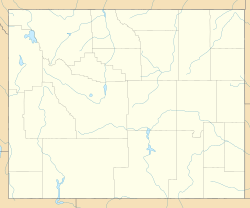Holland House (Buffalo, Wyoming) facts for kids
Quick facts for kids |
|
|
Holland House
|
|

Holland House
|
|
| Location | 312 N. Main St., Buffalo, Wyoming |
|---|---|
| Area | 1.5 acres (0.61 ha) |
| Built | 1883 |
| NRHP reference No. | 93001185 |
| Added to NRHP | November 4, 1993 |
The Holland House is a historic home in Buffalo, Wyoming. It was built way back in 1883. This house was one of the very first brick homes in Buffalo. Because it's so important, it was added to the National Register of Historic Places in 1993. This means it's a special building recognized for its history.
Contents
Meet the Holland Family
William Henry Harrison Holland was born in 1840. He fought in the American Civil War from 1862 to 1865. He was hurt three times during the war. He also spent nine months as a prisoner of war. After the war, he went back home to Sangamon, Illinois. He married Ruth Ann Canterbury in 1867.
In 1879, Holland came to Wyoming and worked as a cowboy. A year later, in 1880, he moved to Johnson County. He was the first person in Johnson County to claim land under the Homestead Acts. These acts allowed people to get land if they lived on it and farmed it.
In the spring of 1881, he brought his family from Cheyenne. They traveled in a wagon train with two wagons and an Army ambulance. The trip took three weeks!
Harrison Holland's Life in Buffalo
On October 2, 1882, "Harrison" Holland became a Johnson County Commissioner. This meant he helped make important decisions for the county. He won a full term from 1883 to 1885. He was one of the leaders when the Johnson County Courthouse was built. His name is even on the building's cornerstone!
Holland built the Holland House at 312 North Main Street in Buffalo. He and his family moved in on Christmas Day, 1883. What's really cool is that the house has stayed in the Holland family for five generations! It's the only pioneer home in Buffalo still owned by the original family. "Harrison" Holland passed away in 1906, and his wife died in 1917.
Later Generations of Hollands
"Harrison's" son, Albert Carlisle Holland, married Isolina Christina Holland in 1891. Albert and Isolina lived in the Holland House starting in 1920. They had three daughters and one son.
"Harrison's" grandson, William C. Holland, married Marian Josephine Richter in 1929. William C. was the mayor of Buffalo from 1946 to 1950. He also served in the Wyoming State Legislature for many years. He helped write the history of Buffalo for its 100th birthday. William died in 1993, and his wife passed away in 2003.
Their son, Charles William Holland, was "Harrison's" great-grandson. He was born in 1939 and died in 2003.
Two of William C. Holland's daughters also played important roles. Elaine Hough helped write the application to get the house on the National Register of Historic Places. Kathleen Holland Matuska was a leader for the Jim Gatchell Museum in Buffalo. She helped raise money for the museum and was active in the community.
About the Holland House Itself
The land for the Holland House was given to William Henry Harrison Holland by Mrs. Juliet W. Hart. She said the house had to cost at least $2500.00 to build. Edward Curren was the builder. He also built the Johnson County Courthouse.
House Style and Features
The Holland House is a great example of a late Victorian style brick house. It has fancy arches above the windows. You can also see decorative shingles on the pointed parts of the roof called gable ends. There's a special bay window that sticks out on the south side.
The house is shaped like an "L" with a rectangular part added to the back. It's one and a half stories tall. The main roof is pointed, with smaller pointed roofs on the front and back.
The bricks for the house came from the Buffalo Brick Company. They are laid in a pattern called a common bond. The bottom part of the house, called the foundation, is covered with red stucco. This covers about a quarter of the front wall. Two windows are on either side of the front door. Two rows of bricks are placed above the windows to form arches.
Entrance and Porches
The front door is a 1930s style colonial revival door. It has a fanlight, which is a window shaped like a fan, above the glass storm door. A small, pointed roof covers the front steps. This roof replaced an older porch that was removed for safety.
A bay window is in the middle of the house's south side. It has three windows that open by sliding up and down. A screened-in porch was added in the 1890s. It's located south of the bay window. In 1956, glass windows were added to this porch, turning it into a sun porch. A flat roof covers the back porch. You can get to the back of the house through the sun porch.
Inside the House
The original inside of the house had a central hallway. There was a living room on one side and a parlor (a formal sitting room) on the other. Stairs to the upstairs were in the central hall. The kitchen and pantry were in the back. Three bedrooms were located upstairs.
The house was updated a bit in 1937 and 1956. Now, there is one bedroom upstairs. The house is shaded by very old cottonwood trees. These trees are over 100 years old and were planted by the first owner, Harrison Holland.



